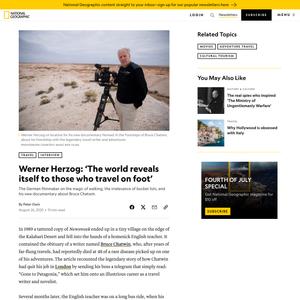
Pathfollowing, in short, is not so much intentional as attentional. It draws the follower out into presence of the real. As intention is to attention, therefore, so absence is to presence. This is also the difference between wayfaring and navigation.
Yet the intentional traveller, wrapped up in the space of his own deliberations, is, by the same token, absent from the world itself. He must perforce decide which way to go, but having resolved upon a course, has no further need to look where he is going.
There are many ways of walking, and not all of them lead out. One way that does not, which you may recall from childhood, is the ‘crocodile’. It is what teachers use for getting a class without mishap from one point to another. Children are expected to walk two abreast, in a neat line. If they pay attention to their surroundings at all, it is in the interests of safety, to avoid collision with traffic or passers-by. The path of the crocodile, however, is not a way of learning; this happens only at its destination, where once again the teacher stands before the class and addresses them. But when these same children – be they accompanied by a parent or guardian, with friends, or on their own make their ways from home to school and back, they will walk quite differently. Now hurrying, now dawdling, alternately skipping and plodding, the child’s attention is caught – or, in the view of an accompanying adult, distracted – by everything from the play of light and shadow to the flight of...
Walking is about putting this position at stake, it is about ex-position, being out-of-position.
That is exactly what walking is about: a displacement of the gaze that enables experience, not just as a passive undergoing (being commanded), but also as blazing a trail or path, a kind of cutting a road through.
A poor pedagogy does not put under surveillance, does not monitoring, has no kingdom to guard over (the kingdom of science, of rationality, of morality, of humanity, etc.). It does not impose entrance conditions, but invites us to go and walk the roads, to go into the world, to copy the text, i.e. to expose ourselves. Walking the roads means literally to leave the comfort of home to go into the world. The world is the place, which belongs to no-one, which has no entrance gate which has to be put under surveillance. To go into the world, it suffices to make an effort (to go walking, copying). What is needed is the will to move and to exhaust the energy of projection and appropriation (which time and again establishes its own order or ‘home’); what is needed is a concrete effort as a kind of disciplining of the body and the mind which is not a matter of normalizing our position, but in a sense weakens it. Walking and copying are such physical disciplining activities.
There is of course a whole literature on walking as a research tool, as a ritual, as performance, as intervention, as a tool for sharing insights and as embodiment of the critical process (see for example, University of Illinois (2005), Le Breton (2000); Solnit (2002)). Walking straight, arbitrary lines is a practice also well known in art (see for example, Long (2002), or Adams and Malone (2003); see also Careri (2002); Davila (2002). Referring to Enlightenment, Jacques Rancie` re once noted that one of the essential budget posts of the emancipated individual was the cost of shoes, ‘for the emancipated man is a man who walks and walks, moving around and conversing, putting meaning into circulation and promoting the movement of emancipation’ (Rancie` re 2007, 51).
The point about walking is not that it would offer us a ‘better’ view (or ‘reading’) or a more true, more complete view, that it would allow us to transgress the limits of our perspective, but that it offers us, so to speak, a view beyond every perspective, a look that transforms us (and therefore constitutes experience), while its evidence commands us.
E-ducating the gaze is not about getting at a liberated or critical view, but about liberating or displacing our view. It is not about becoming conscious or aware, but about becoming attentive, about paying attention. E-ducating the gaze, then, is not depending on method, but relying on discipline; it does not require a rich methodology, but asks for a poor pedagogy, i.e. for practices which allow to expose ourselves. One example of such practice is that of walking. Consequently e-ducating the gaze could be about an invitation to go walking.


"To lose a passport was the least of one’s worries. To lose a notebook was a catastrophe.
Bruce Chatwin"
"I haven't got any special religion this morning. My God is the God of Walkers. If you walk hard enough, you probably don't need any other god.
Bruce Chatwin"
“We should be careful about the myth of the forest because when you quote the sentence “truth travels on foot through the forest” [sic], for me the centre is travelling on foot. The world reveals itself to those who travel on foot. I am not going to explain it any further because nobody is travelling on foot anymore, so I can say it only as a dictum. The forest reveals its truth for those who are travelling through it on foot. We shouldn’t dwell on it, because we are on the internet and whoever sees this is going to be on the internet and nobody will travel on foot a thousand miles. I am a lazy bum as well like everyone else, but I do travel on foot when there is something of existential importance. Then I will do it on foot.”


